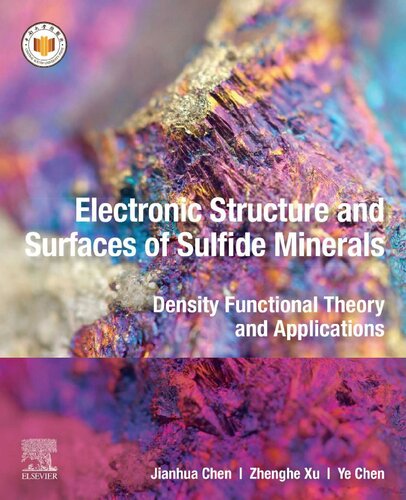(Ebook PDF) Electronic Structure and Surfaces of Sulfide Minerals Density Functional Theory and Applications 1st edition by Jianhua Chen, Zhenghe Xu, Ye Chen 0128179759 9780128179758 full chapters
$50.00 Original price was: $50.00.$25.00Current price is: $25.00.
Electronic Structure and Surfaces of Sulfide Minerals: Density Functional Theory and Applications 1st edition by Jianhua Chen, Zhenghe Xu, Ye Chen 0128179759 9780128179758 – Ebook PDF Instant Download/DeliveryISBN:
Full download Electronic Structure and Surfaces of Sulfide Minerals: Density Functional Theory and Applications 1st edition after payment.

Product details:
ISBN-10 : 0128179759
ISBN-13 : 9780128179758
Author: Jianhua Chen, Zhenghe Xu, Ye Chen
Electronic Structure and Surfaces of Sulfide Minerals: Density Functional Theory and Applications examines the mineral structure and electronic properties of minerals and their relationship to mineral floatability by density functional theory (DFT). This pragmatic guide explores the role of minerals in flotation by focusing on the mineral surface structure, electronic properties, and the adsorption of flotation agents through the study of the microscopic mechanism of reagents from the structure and properties of minerals. The flotation mechanism is explained from the point-of-view of solid physics, which is of great significance for both theoretical research and practical applications.
Electronic Structure and Surfaces of Sulfide Minerals: Density Functional Theory and Applications 1st Table of contents:
1 – Introduction of density functional theory
1.1 Introduction
1.2 Thomas−Fermi model
1.3 Hohenberg−Kohn theorem
1.4 Kohn−Sham equation
1.5 Exchange-correlation energy functional
1.5.1 Local density approximation
1.5.2 Generalized gradient approximation
1.6 Energy band theory
1.6.1 Bloch’s theorem
1.6.2 The first Brillouin zone
References
2 – Electronic properties of sulfide minerals and floatability
2.1 Crystal structure and electronic properties of copper sulfide minerals
2.1.1 Crystal structure of copper sulfides
2.1.2 Computational methods
2.1.3 The electronic properties of copper sulfide
2.1.4 Bonding analysis of copper sulfide minerals
2.1.5 Frontier orbitals
2.1.6 Floatability and electronic properties for copper sulfide minerals
2.2 Crystal structure and electronic properties of iron sulfide minerals
2.2.1 Crystal structure and floatability of iron sulfides
2.2.2 Band structure of iron sulfides
2.2.3 Spin polarization of iron sulfide
2.2.4 Bonding between S and Fe atoms
2.2.5 Bond Mulliken population
2.2.6 Frontier molecular orbital
2.3 Crystal structure and electronic properties of lead–antimony sulfide minerals
2.3.1 Computational methods
2.3.2 Effects of crystal structures
2.3.3 DOS analysis of jamesonite, galena, and stibnite
2.3.4 Analysis of frontier orbital
2.4 Electronic and chemical structures of pyrite and arsenopyrite
2.4.1 Crystal structure
2.4.2 Computational methods
2.4.3 Crystal structure differences between pyrite and arsenopyrite
2.4.4 Electronic structures
2.4.5 Fermi level of pyrite and arsenopyrite
2.4.6 Frontier molecular orbital of pyrite and arsenopyrite
2.5 Electronic structure and flotation behavior of monoclinic and hexagonal pyrrhotite
2.5.1 Introduction
2.5.2 Computational methods and models
2.5.3 Energy band and density of states
2.5.4 The electrons density of monoclinic and hexagonal pyrrhotite
2.5.5 Frontier orbital calculations
2.5.6 Flotation behavior of monoclinic and hexagonal pyrrhotite
2.6 Galvanic interaction between pyrite and galena
2.6.1 Introduction
2.6.2 Effect of galvanic interaction on mineral flotation
2.6.3 Effect of contact distance on the galvanic interaction
2.6.4 Electron transfer between mineral surface atoms
2.6.5 Nucleophilicity and electrophilicity of surfaces
2.6.6 Orbital coefficients of surface atoms
2.6.7 DOS of surface atoms
2.6.8 Effect of H2O and N2 molecules at the interface of pyrite and galena on the galvanic interacti
References
3 – Surface relaxation and electronic properties of sulfide minerals
3.1 Development of surface electronic states
3.1.1 Startup period
3.1.2 Comprehensive development period
3.1.3 Mature period
3.2 Surface relaxation and surface states: foundation
3.2.1 Surface relaxation
3.2.2 Surface state
3.2.3 Slab model
3.3 Surface relaxation and surface state of sulfide minerals
3.3.1 Surface relaxation of sulfide mineral
3.3.2 Surface state energy level of sulfide mineral surface
3.4 Density of states of sulfide minerals surface
3.4.1 Density of states of surface
3.4.2 Charge distribution of surface atoms
3.5 Effect of surface structure on the electronic properties
3.6 Surface atomic reactivity on sulfide minerals
3.6.1 Frontier orbital coefficient
3.6.2 Fukui functions
References
4 – Interaction of water and oxygen with sulfide mineral surface
4.1 Effect of water molecule on surface relaxation
4.1.1 Computational method
4.1.2 Relaxation of minerals surfaces after adsorption of H2O molecule
4.1.3 Effect of density of states on sulfide minerals surfaces in presence of H2O molecule
4.1.4 Effect of Mulliken populations on sulfide minerals surfaces in presence of H2O molecule
4.2 Adsorption of multilayer water molecules on galena and pyrite surfaces
4.2.1 Computational methods
4.2.2 Adsorption of isolated water molecule
4.2.3 Excess water molecules adsorption
4.2.4 Structure and electronic properties of galena and pyrite surfaces
4.3 Interaction of water and oxygen on the pyrite surface
4.3.1 Computational methods
4.3.2 Isolated H2O/O2 molecule adsorption
4.3.3 Coadsorption of H2O–O2 on pyrite surface
4.4 Coadsorption of water and oxygen on the galena surface
4.4.1 Computational models and methods
4.4.2 Adsorption of a single oxygen molecule
4.4.3 Adsorption of a single water molecule
4.4.4 Sequential coadsorption of water and oxygen on the PbS (100) surface
4.4.5 Simultaneous coadsorption of water and oxygen on the PbS (100) surface
References
5 – Structure and reactivity of flotation reagents
5.1 Density states of collector molecules
5.1.1 Methods
5.1.2 Xanthate-type collector
5.1.3 Bonded atoms of xanthate-type collector
5.1.4 Aerofloat collector
5.1.5 Thiocarbamate collector
5.2 Structure–activity of chelating collectors
5.2.1 Computational details
5.2.2 Frontier orbital results
5.2.3 Interactions of metals with chelating collectors
5.3 Azo compound depressants
5.3.1 Computational methods
5.3.2 Effect of azo reagents on sulfide minerals flotation
5.3.3 Relationship between molecular structure and depression properties of azo agents
5.3.4 Frontier orbital energy of azo agents and minerals
5.4 Frothers adsorption at water–gas interface
5.4.1 Computational method
5.4.2 Frother molecule in water phase
5.4.3 Frother molecule adsorbing at the gas–liquid interface
5.4.3.1 α-terpineol
5.4.3.2 MIBC
5.4.3.3 DF200
5.4.4 Frother adsorption layer at the gas–liquid interface
References
6 – Interaction of flotation reagents with mineral surface
6.1 Interaction of xanthate on galena and pyrite surfaces
6.1.1 Computational details
6.1.2 Adsorption of xanthate on minerals surfaces in the absence of oxygen
6.1.3 Adsorption of xanthate on minerals surfaces in the presence of oxygen
6.1.4 Formation of dixanthogen
6.2 Adsorption of xanthate, dithiophosphate, and dithiocarbamate on galena and pyrite surfaces
6.2.1 Experimental and computational methods
6.2.2 The electronic structure and properties of galena (100) and pyrite (100) surfaces
6.2.3 The geometry and electron density of collector adsorption
6.2.4 The analysis of density of states
6.2.5 The heat of adsorption of collectors on galena and pyrite surfaces
6.2.6 Kinetics of collector adsorption on galena and pyrite surface
6.3 Copper activation of sphalerite and pyrite surfaces
6.3.1 Activation model of sphalerite and its electronic properties
6.3.2 Activation model of pyrite and its electronic properties
6.4 Interaction of lime with pyrite surface
6.4.1 Methods
6.4.2 Adsorption of OH– and CaOH+on pyrite surface
6.4.3 Copper activation of pyrite depressed by NaOH and CaO
6.5 The adsorption of cyanide on pyrite, marcasite, and pyrrhotite
6.5.1 Computational methods and models
6.5.2 Adsorption of CN– on pyrite, marcasite, and pyrrhotite surfaces
6.5.3 Effect of sodium cyanide dosage on the grade and recovery of iron
6.6 Effect of water molecules on the thiol collector interaction on galena and sphalerite surfaces
6.6.1 Computational methods
6.6.2 Effect of water molecule on the surface properties of ZnS (110) and PbS (100)
6.6.3 Effect of water molecule on the sphalerite surface reagent adsorption
6.6.4 Effect of water molecule on galena surface adsorption
6.6.5 Effect of water molecule on the selectivity of collector in the separation of lead and zinc su
References
7 – Electronic structures and surface adsorption of impurity-bearing sulfide minerals
7.1 Effect of impurities on the floatability of sulfide minerals
7.2 Effect of impurities and defects on the lattice constants of sulfide minerals
7.3 Effect of impurities and defects on the band gap
7.4 Impurities contribution on the properties of sulfide mineral: the frontier orbital coefficient s
7.5 Occurrences and correlation of Au and As in pyrite
7.5.1 Computational details
7.5.2 Correlation of Au and As in pyrite
7.5.3 Crystal structure of pyrite containing Au and As
7.5.4 Electronic structures of Au- and As-bearing pyrite
7.6 Effect of impurities on the band structure and oxidation of galena
7.6.1 Computational methods
7.6.2 Effects of impurity on electronic band structure of galena
7.6.3 Adsorption energy and structure
7.6.4 DOS analysis of oxygen with galena surface bearing impurities
7.6.5 Electron density map
7.6.6 Cyclic voltammetry examination
7.7 Activation and collecting of impurity-bearing sphalerite
7.7.1 Effect of impurities on the band structure of sphalerite surface
7.7.2 Effect of impurities on flotation behavior of sphalerite
7.8 Effect of impurities on the interaction between galena and xanthate
People also search for Electronic Structure and Surfaces of Sulfide Minerals: Density Functional Theory and Applications 1st:
sulfide electron
electronic structure of sulphide ion
sulfide and sulfate minerals
write the electron dot structure of sulphur
sulphur 8 electron dot structure
Tags:
Electronic Structure,Surfaces,Sulfide Minerals,Density Functional,Theory,Applications, Jianhua Chen,Zhenghe Xu,Ye Chen
You may also like…
Science (General)
Fluid Inclusion Effect in Flotation of Sulfide Minerals 1st Edition
Biology and other natural sciences - Biotechnology
Science (General)
Engineering - Industrial Engineering & Materials Science
Uncategorized












